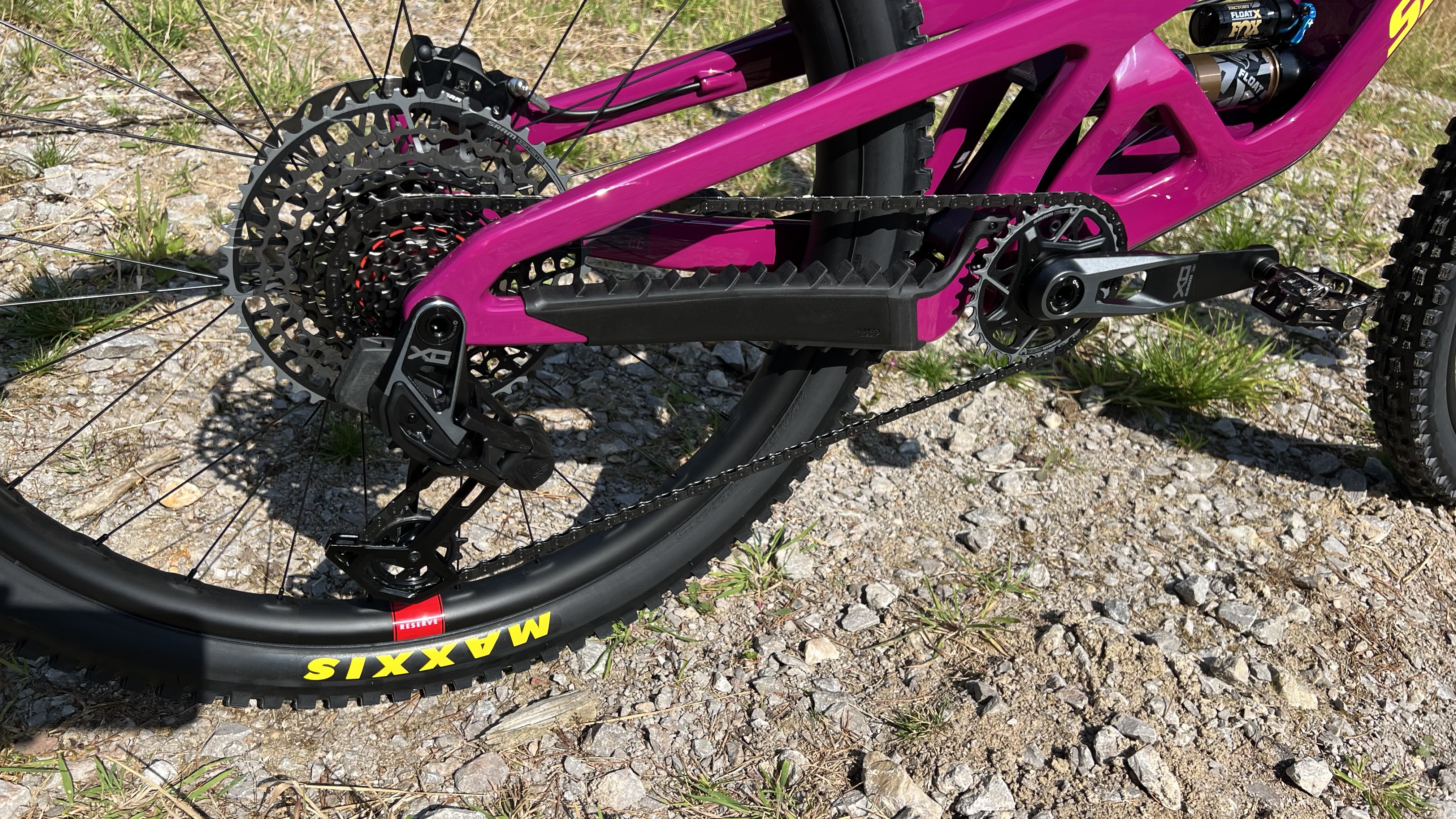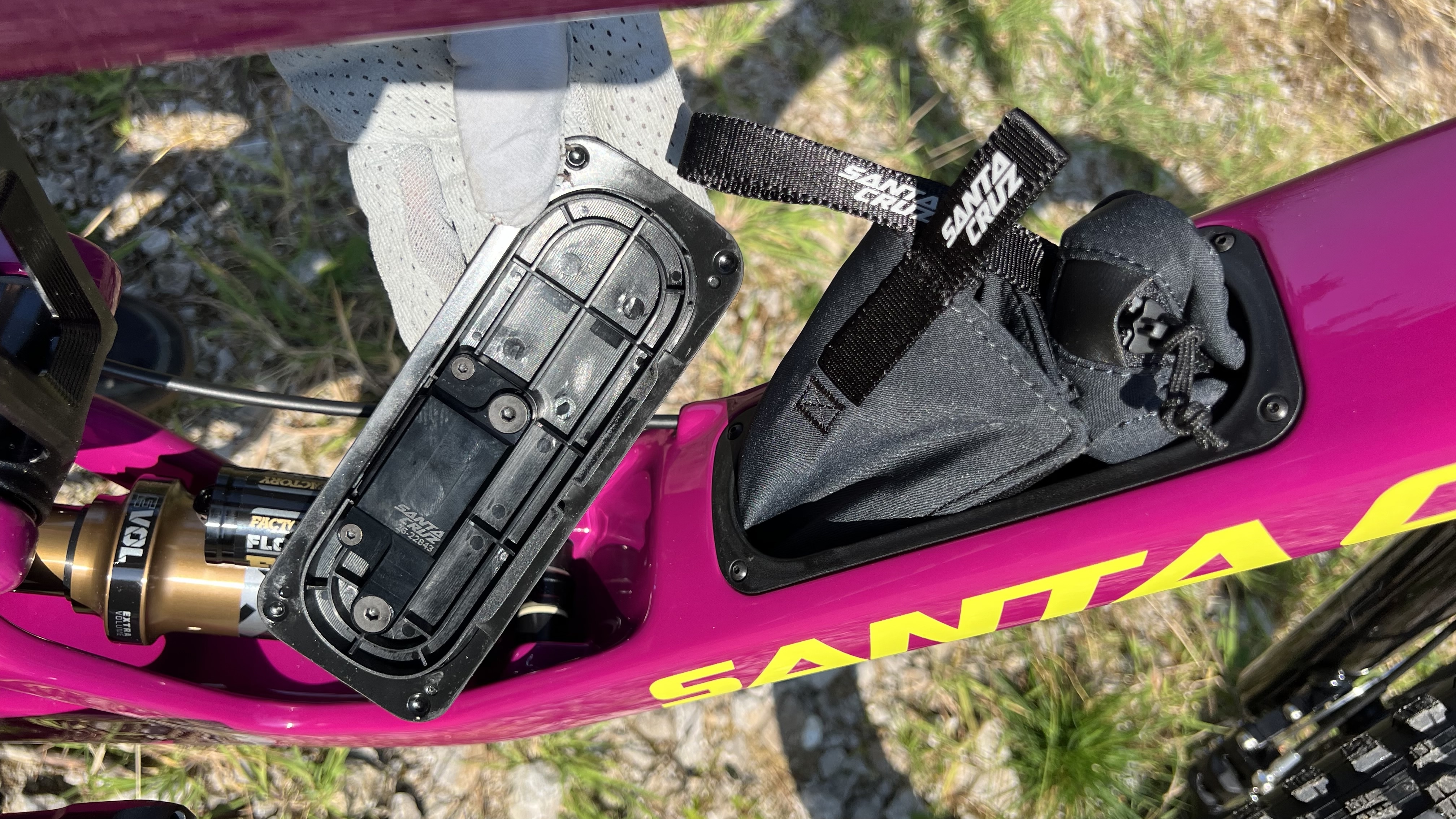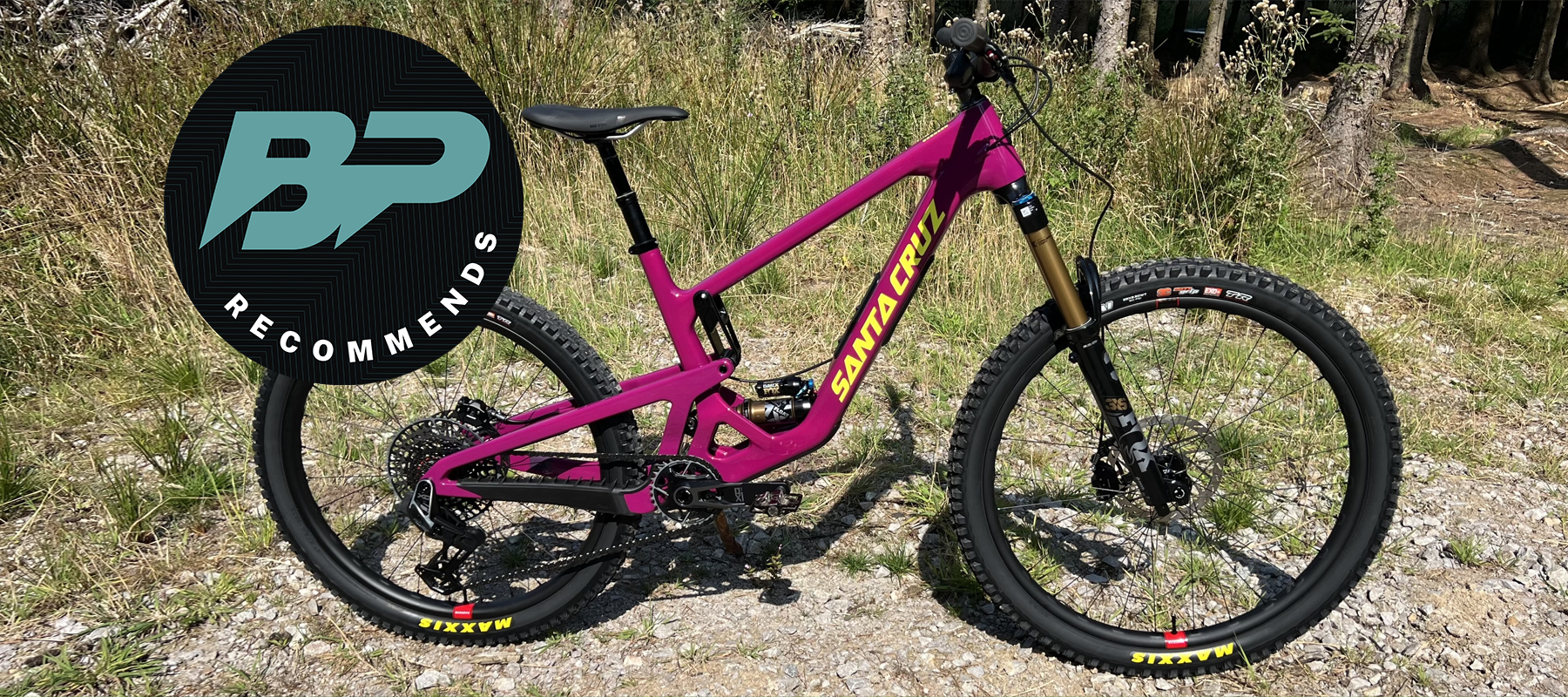Bike Perfect Verdict
Santa Cruz’s move towards four bar manners and gravity geometry makes it more stable, controlled, and safer in steeper situations but reduces its signature playful pop and adds significant weight.
Pros
- +
More stable geometry for steeper, sketchier terrain
- +
Less anti-squat means better traction, particularly under power
- +
Balanced handling splits the difference between mullet and twin 29er
- +
‘No questions asked’ warranty on frame, bearings, and rims
- +
Sorted spec includes a gravity-optimized front fork, tire, and brakes
Cons
- -
Much heavier than Bronson 4
- -
Soft pedaling ‘4 bar’ feel compared to previous Santa Cruz
- -
Not as playful as most mullet/MX bikes
- -
Very different baseline forks and shocks need careful setup to sort
Why trust BikePerfect
Bronson was the first Santa Cruz trail bike to use a mixed wheel size (MX) layout, but its design team says they’ve learned a lot of lessons with the V10, Nomad, 5010, and Heckler SL MX bikes. The new Bronson definitely benefits from those geometry lessons and a more neutral version of the signature VPP suspension when it comes to downhill control too. That undoubtedly reflects the trend that popularised MTB is following but some riders might miss its previous playfulness and midweight agility.

Design and geometry
The fifth Bronson follows the signature Santa Cruz frame layout of the past two generations of trail bikes. The belly of the downtube is now a trough rather than a box section. This means they can get the shock lower and flatter. It does eat into the internal storage space ahead of the bottom bracket.
The straddle section of the ‘seat tube’ is triangulated now, leaving a larger window to check the sag ring. Access to the geometry change flip-chip and lower bearing grease injection nipple is also easier. Checking how much travel you’ve used is relatively awkward though.
Otherwise, the ‘Glovebox’ storage hatch has been tidied up and gets a better catch. It also uses the big rubber flap chainstay protector of the Heckler SL E-bike as well as belly and downtube armor for tailgate protection. Santa Cruz’s DIY adjustable collet bearing pivots match to a bearing mount on the back of the Float X2 piggyback shock. The lower linkage is also rolled forward above the bottom bracket. This reduces anti-squat by 20 percent (from 130 to 110) at the sag point according to Cruz’s charts. The premium CC carbon frame tested here is 300g lighter than the C model on cheaper builds and also has wireless-specific cable routing. At nearly 4kg with shock and axle, even the CC is a chunky frame for a composite bike. You do get a lifetime ‘no questions asked’ warranty though.
Geometry is given extra gravitas with a half-degree slacker 63.9-degree head angle in the low setting, a much steeper 77.9-degree seat angle, and a 6mm longer 478mm top tube to compensate. Santa Cruz’s ‘learnings’ from other MX bikes means they’ve stretched the rear center length out again to 443 on the large I tested. That’s longer than the 29er rear-wheel Hightower and only 0.8mm off the rear center of the Heckler SL E-MTB with its extra motor clearance considerations.

Specification
I tested the top-spec XO AXS RSV bike with 160mm travel flagship Factory grade Fox Float 36 fork using the new GRIP X2 damper. That’s matched in gold anodized color and Factory grade by the Float X2 rear shock. The actual performance isn’t so matched though which we’ll get onto later.
SRAM provides the alloy-cranked XO wireless group set and powerful Maven brakes tempered with a 180mm rotor on the rear. The One Up V3 post is an excellent, reliable option but the straddle seat tube design restricts usable length, so you only get a 180mm stroke which might make some folk grumble. Santa Cruz’s carbon bar has a great shape and feel and the lifetime warrantied Reserve carbon wheels are the Heavy Duty version, although they’re not much heavier than the SLs. Finally, all Bronson builds use a MaxxGrip Assegai front and MaxxTerra DHR rear tire spec. A reinforced DD tire would seem to match the new bike’s intent better than the lighter EXO+ carcass you get. Especially as the new Bronson 5 is nearly a kilo heavier than the Bronson 4 despite largely similar weight spec.

Performance
The extra weight, combined with the more raked-out fork and the Fox shock settling into its sag more easily, immediately gives the new Bronson a much more solid, planted feel. The longer rear end and steeper seat angle push you further forward in the bike too, which helps load the naturally very damped feeling, high-riding Fox fork. The steeper the terrain falls away, the better that new geometry works, with more load going into the fork and the super supple rear still finding grip where a stiffer more brake-reactive suspension system might skip and skid. The smaller rear rotor helps reduce the brake effect and the longer rear end also increases traction. As a result, I was generally thinking a lot less about the back end of the bike than I have historically on Santa Cruzs, particularly MX-wheeled ones. I can see many riders switching to a DD carcass rear tire though as the smaller wheel and more vertical axle path of the reconfigured VPP make it more likely to slap sharp edges and bigger rocks which could split the EXO+ tire.
While the longer back end means it’s not as marked as most mullet/MX bikes, which are dying to drop in and/or skid steer at any moment, the different diameters of wheel still require less effort for committed corner entry. Big lean angles are also easier to get into and out of than a twin 29er. The naturally soft, stroke-eager rear shock makes it reasonably easy to get the nose up too. Again it’s less so than an MX bike with a short rear center though so Santa Cruz’s “still loves back wheel” claim is a bit of a stretch.

While it works super well in the steeps and undoubtedly kept me on track and out of trouble when I overstepped the mark at the edge of my skill set, the suspension needs balancing for flatter trails. Specifically, I had to add a lot of low-speed compression and run a higher pressure than I normally would with the super smooth rear shock to keep it higher and tighter. I had to run the low and high-speed compression on the GRIP X2 damper fully open to try and find some sensitivity and depth in the fork. Otherwise, it still felt aloof and skatey on flatter loose or wet trails even with the normal glue like MaxxGrip Assegai up front.
That same stiffer shock setup also reduces the soft, kick-diluting pedal feel caused by the reduced anti-squat. The higher overall weight is still obvious when accelerating or trying to gain altitude at pace though. That sticky front tire and slower roll of the smaller rear tire don’t help you hustle the pace either, although the Reserve 30HD wheels are pretty light and have a naturally precise and ‘clean’ feel compared to the more compliant 30SL rims.

Verdict
It’s fair to say that ‘Trail’ now inhabits the space that would have been called ‘Enduro’ a few years ago. Popular trails are becoming steeper and steeper and the jumps are bigger every time someone picks up a spade and starts a new one too. That’s exactly the world that the latest Bronson has been bred for too and it’s undoubtedly a more controlled and safer feeling than before. Not just compared to previous Bronsons but most other mullet/MX bikes too. The lifetime warranties, Santa Cruz’s customer service reputation, and significant investment in trail building and advocacy projects make the high price an investment in terms of your future and the future of mountain biking in general too.
Heavier weight, less punchy pedaling, and a more isolated feel between rider and suspension mean it’s not the giddy play bike it used to be though, so look to the shorter travel 5010 if you want a more agile Santa Cruz. If you go for this top-spec model with the GRIP X2 fork be prepared to spend time tuning the front and rear balance into the suspension too.
| Attributes | Notes | Rating |
|---|---|---|
| Descending | More stable, smoother suspension and control boosting spec grippy, and with plenty of control | ★★★★★ |
| Climbing | Heavier than before and softer pedalling with soft front tire and slow rolling rear | ★★★ |
| Components and build | Control boosting spec suits geo changes but fork and shock are unbalanced | ★★★ |
| Value for money | Excellent build quality, customer support and MTB investment credentials | ★★★★ |
Tech specs: Santa Cruz’s Bronson XO AXS RSV
- Discipline: Trail, Enduro, Gravity
- Price: $8,699 / £8,799
- Head angle: 63.9 degrees (low)
- Frame material: Carbon CC
- Size: XS, S, M, L, (tested) XL, XXL
- Weight: 14.98kg (size L actual)
- Wheel size: 29in/27.5in
- Fork: FOX FACTORY 36 GRIPX2/160mm travel
- Rear shock: Fox Factory Float X2 150mm travel
- Chainset: SRAM XO 170mm arms with 32T chainring and DUB bottom bracket.
- Rear mech: SRAM Eagle AXS XO1, T-Type Transmission
- Shifter: SRAM Eagle AXS Pod Controller
- Cassette: SRAM Eagle XO CS-1275 12-speed 10-52T
- Brakes: SRAM Maven Bronze Stealth brakes with 200/180mm rotors
- Tires: Maxxis Assegai MaxxTerra EXO+ 29 x 2.5in front, Minion DHR2 27.5 x 2.4in rear
- Wheels: Reserve 30HD rims on Industry Nine 1/1 hubs
- Bars: Santa Cruz 800mm carbon riser bar
- Stem: Burgtec Enduro Mk3 42mm
- Grips: Pivot Phoenix Factory lock-on
- Seat post: One Up V3 180mm
- Saddle: WTB Silverado saddle

Guy Kesteven has been working on Bike Perfect since its launch in 2019. He started writing and testing for bike mags in 1996. Since then he’s written several million words about several thousand test bikes and a ridiculous amount of riding gear. He’s also penned a handful of bike-related books and he reviews MTBs over on YouTube.
Current rides: Cervelo ZFS-5, Specialized Chisel, custom Nicolai enduro tandem, Landescape/Swallow custom gravel tandem
Height: 180cm
Weight: 69kg

